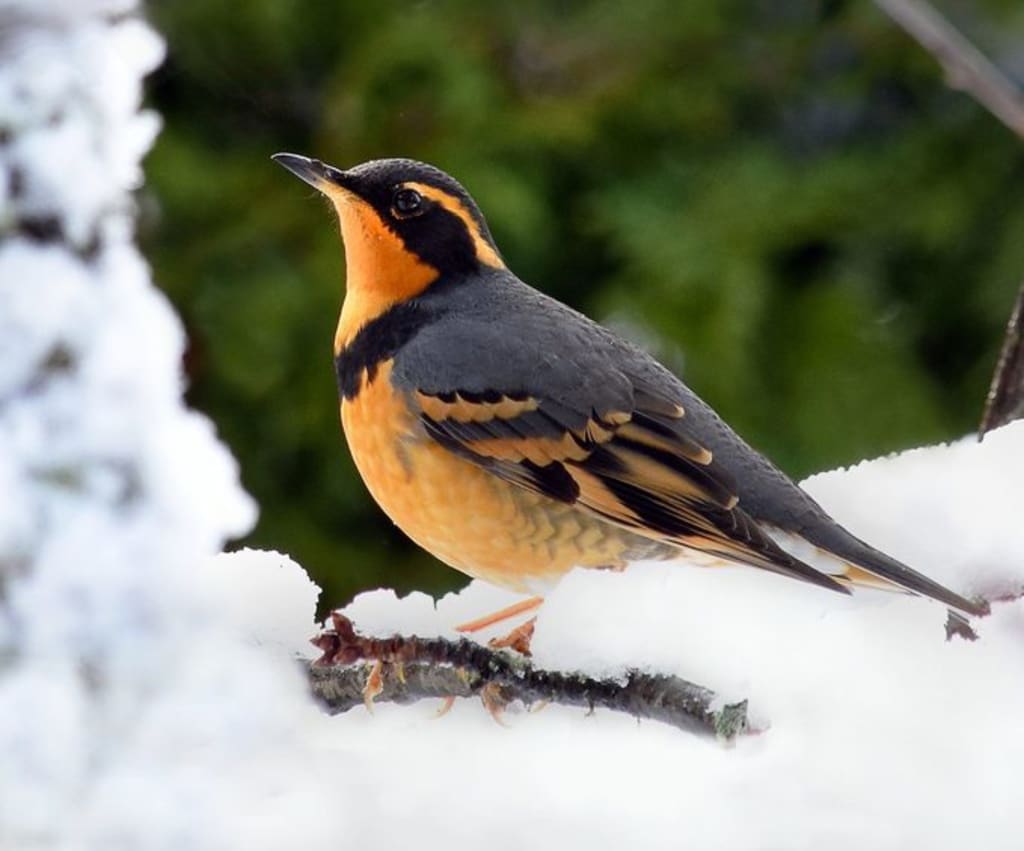
Introduction
The Varied Thrush (Ixoreus naevius) is a medium-sized songbird, belonging to the family Turdidae, which includes thrushes, robins, and bluebirds. It is native to the western region of North America and is known for its striking plumage, unique vocalizations, and distinctive behavior. In this essay, we will provide a comprehensive overview of the Varied Thrush, including its taxonomy, physical characteristics, habitat, diet, behavior, and conservation status.
Taxonomy
The Varied Thrush was first described by John James Audubon in 1839. Its scientific name, Ixoreus naevius, is derived from the Greek words "ixos" (meaning mistletoe), "oreos" (meaning mountain), and "naevius" (meaning spotted). This bird is part of the genus Ixoreus, which also includes the Aztec Thrush (Ixoreus castaneoventris) and the Black Robin (Ixoreus naevioides). It is classified in the family Turdidae, which is a group of passerine birds that includes thrushes, robins, and bluebirds.
Physical Characteristics
The Varied Thrush is a medium-sized bird, measuring about 20 to 25 centimeters in length and weighing approximately 65 to 75 grams. It has a short, stout bill and a plump body with a relatively short tail. The male and female have similar physical characteristics, with the male being slightly larger and more brightly colored.
The most distinctive feature of the Varied Thrush is its striking plumage. The bird has a bright orange breast and belly, a black back and head, and a white stripe above the eye. The wings are blue-gray with white bars, and the tail is black with white corners. The orange and black colors of the Varied Thrush are thought to be a form of aposematic coloration, which is a warning signal to predators that the bird is toxic or unpalatable.
Habitat
The Varied Thrush is found in the western region of North America, from Alaska and northern Canada to California and the Rocky Mountains. It is primarily a bird of coniferous forests, where it prefers moist, shady habitats with dense undergrowth. The bird is also found in mixed forests and riparian areas, where it can find a variety of food sources.
During the breeding season, the Varied Thrush is found at higher elevations, up to 3,000 meters above sea level. In the winter, the bird moves to lower elevations and can be found in urban and suburban areas, as well as in parks and gardens.
Diet
The Varied Thrush is an omnivore, feeding on a variety of insects, spiders, snails, and other small invertebrates, as well as berries, seeds, and fruits. During the breeding season, the bird relies heavily on insects and other arthropods to feed its young. In the winter, when food sources are scarce, the Varied Thrush relies more on berries and fruits.
The bird forages on the ground and in the understory, using its bill to probe and dig for food. It is also known to glean insects from leaves and branches and to hover briefly to catch insects in mid-air.
Behavior
The Varied Thrush is a solitary bird, with a territorial nature. During the breeding season, males establish territories and defend them against other males. The bird is known for its distinctive, flute-like song, which is often described as a series of clear, descending notes. The song is used by males to attract mates and to defend their territory.
The Varied Thrush is also known
These particular thrushes live year-round in the wet forests of the mild Pacific Coast—all the way from southeastern Alaska to Northern California. Farther inland and north they are migratory, nesting in forests from Alaska to the mountains of Montana. They retreat southward and to lower elevations in autumn, when they often visit backyards and city parks.
This species is known for being a notorious wanderer outside of breeding season. It’s been sighted in every state of the Lower 48, often foraging in the midst of a flock of robins. Look closely and you, too, may spot this beauty






Comments
There are no comments for this story
Be the first to respond and start the conversation.